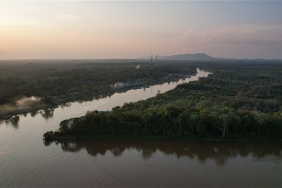GEOTHERMAL DEVELOPMENT: PHILIPPINES VS INDONESIA
By: Indra Sari Wardhani
Geothermal development in the Philippines began in the 1970s when there was an oil and gas crisis in the Philippines. To overcome the crisis, the Philippine government committed to switch to the use of renewable energy, one of which is geothermal. This commitment was confirmed on December 16, 2008 with the signing of the Renewable Energy Act, which aims to accelerate the exploration and development of renewable energy in order to achieve energy independence, reduce the country's dependence on fossil energy and reduce the country's pressure on energy price fluctuations. The update on geothermal development in the Philippines was presented by Mario C. Marasigan, Director IV of the Bureau of Renewable Energy Management, Philippine Department of Energy during the first session of the media trip to the geothermal power plant in Mount Apo.
These policies and regulations are quite successful as by 2013 the share of renewable energy reached 29% in the Philippines' national energy mix and 14% of it or about 1,848 MW came from geothermal energy. The Philippines can be said to be several steps ahead in the development of renewable energy when compared to Indonesia where more than 95% of its national energy mix still comes from fossil energy such as coal, oil and gas, while the share of renewable energy is still less than 5%. Indonesia's national energy policy that targets a 17% share of renewable energy by 2025 is still far from realization. The share of geothermal is only about 1% in the national energy mix, with a current installed capacity of 1,341 MW spread across Sumatra (122 MW), Java (1,334 MW), Nusa Tenggara (5 MW) and Sulawesi (80 MW). Indonesia's geothermal potential is the largest in the world, reaching 28,617 MW spread across 299 locations. With this potential, geothermal utilization in Indonesia can still be optimized.
There are several differences in the direction of energy development in the Philippines and Indonesia. First, the background of different energy conditions where the Philippines is a country that has limited fossil energy resources while Indonesia has abundant fossil energy resources and even Indonesia is one of the largest exporters of oil, gas and coal. Although currently with the increasing domestic energy needs, Indonesia already has to import petroleum and its derivative products.
Second, the Philippines has a law that encourages the development of renewable energy which is clearly aimed at reducing the country's dependence on fossil energy. With the renewable energy law, the Philippines has succeeded in increasing geothermal contracts 3 times, from 13 to 39 contracts. While in Indonesia the current national policy direction is to reduce the share of petroleum to less than 20% by 2025, the share of coal and natural gas has increased to 33% and 30% of the total national energy mix, respectively.
Third, energy prices in the Philippines are based on market prices, no subsidies are provided for all types of energy. However, the Philippine government provides both fiscal and non-fiscal incentives for the development of renewable energy including geothermal, including tax exemptions (income tax holiday) for 7 years and after that the tax is only 10% (fossil energy is 30%), import tariff exemptions for machinery, equipment and materials, direct funding incentives for developers who carry out electrification programs, tax exemptions for carbon credits obtained, net operating loss carry-over for 7 years, and others. Unlike Indonesia, where energy prices, especially fuel oil (BBM) and electricity, are still heavily subsidized by the state. Recorded in the 2013 State Budget, total energy subsidies amounted to Rp. 274,743 billion or about 16% of total state expenditure, consisting of fuel subsidies of Rp. 193,805 billion and electricity subsidies of Rp. 80,938 billion. Incentives for renewable energy in Indonesia are also not sufficiently supportive.
In general, WWF's media trip visit to Mount Apo geothermal power plant is to promote sustainable geothermal development in Indonesia and the Philippines. Through this activity, the participants are expected to gain information, knowledge and experience on how the Philippine government has successfully developed geothermal energy as one of the national energy pillars. The participants were also invited to see how the Philippines synergizes geothermal energy development with environmental conservation efforts and community empowerment by seeing firsthand one of the Mount Apo geothermal power plants (PLTP) which is located within the Mount Apo National Park area and is also the ancestral territory of the Manobo - Apao indigenous people.
Mount Apo PLTP has an area of 701 hectares with an installed capacity of 2x52 MW and has been operating since 1993. The plant was developed by EDC (Energy Development Company) which is the Philippines' largest geothermal company that has successfully developed around 1,155 MW or 65% of the installed geothermal capacity in the Philippines.





